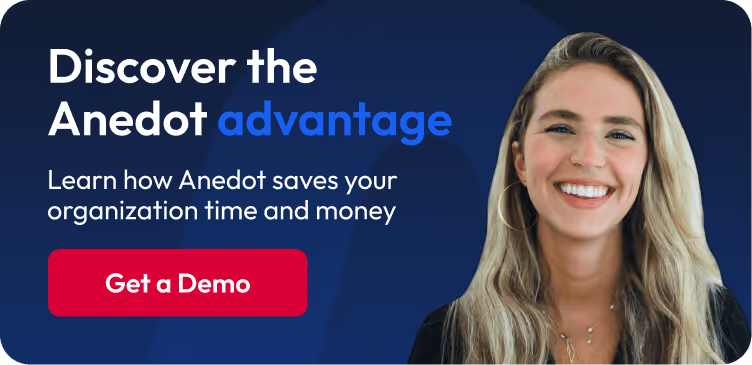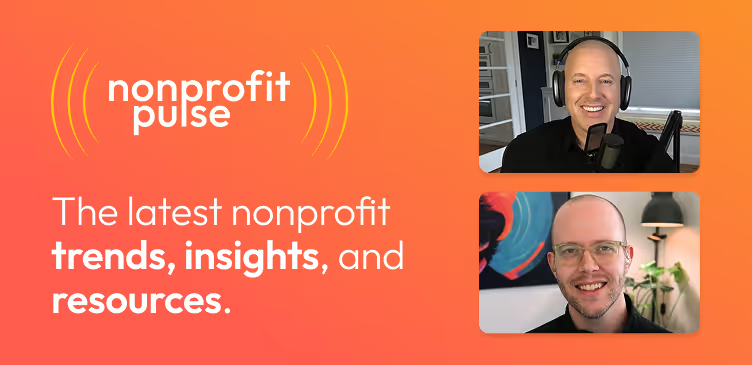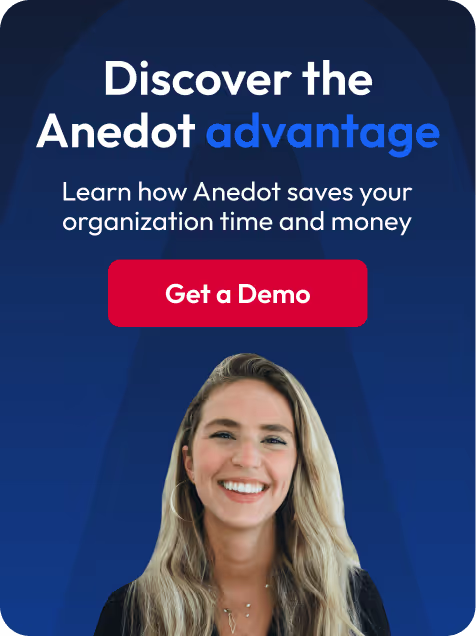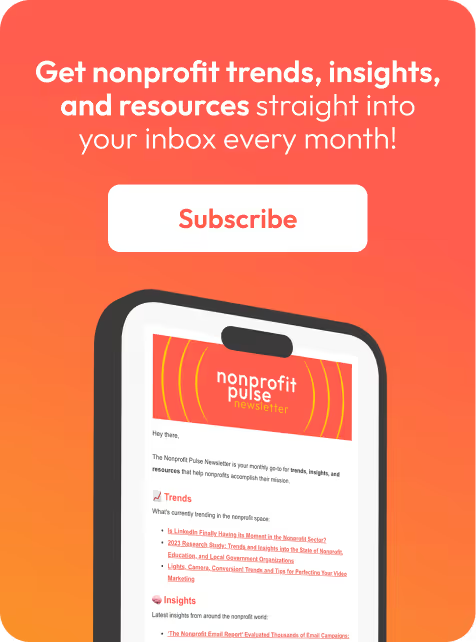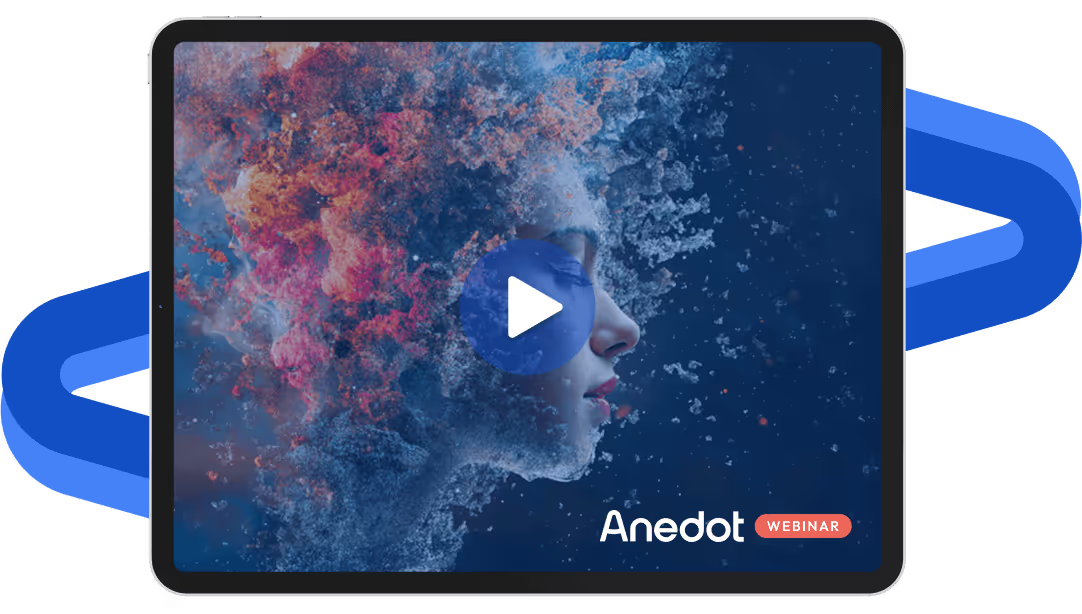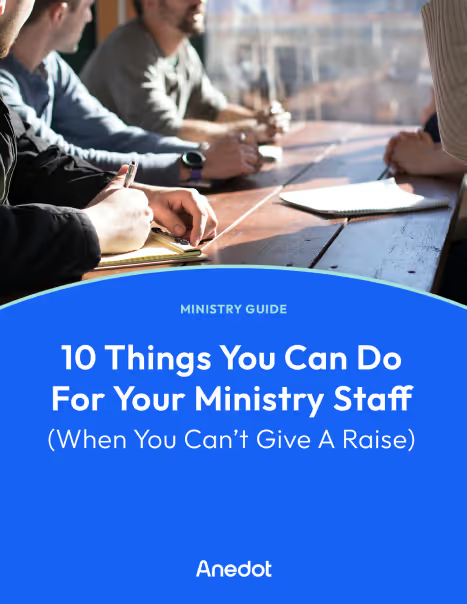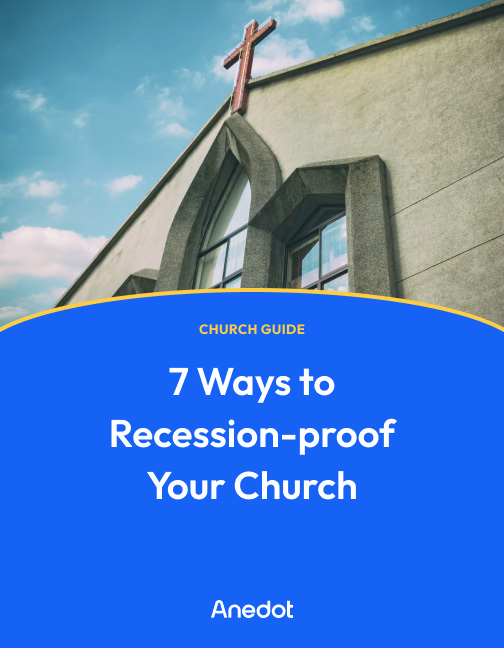Podcast episode transcript ↓
Josh:
Some would say the most successful nonprofits are those that innovate.
By pursuing creativity and embracing new approaches, nonprofits can maximize their impact and address complex issues more efficiently.
However, turning innovative ideas into action is not an easy task.
So what strategies can nonprofits employ to effectively transform their ideas into action?
I'm Josh with Anedot and welcome to Nonprofit Pulse, where we explore trends, insights, and resources that help nonprofits accomplish their mission.
On this episode, we're joined by Leah Kral on the topic of nonprofit innovation for social change.
Leah is the Senior Director of Strategy and Innovation at the Mercatus Center at George Mason University.
She is a sought-after speaker at nonprofit industry events, writes frequently about her research, offers tailored consulting to nonprofit teams, and provides coaching to social entrepreneurs across the country.
Hi, Leah, thanks for joining us on Nonprofit Pulse.
Leah:
Hi, Josh, I'm so excited to be here today.
Josh:
Yes, excited to talk about your book today, Innovation for Social Change, and getting into how wildly successful nonprofits inspire and deliver results.
So maybe first, let's just talk about inspiration for the book.
Was there a particular story or an event that inspired your research and writing on this?
Leah:
Definitely. So yeah, my career ended up taking some unexpected twists and turns.
I actually started out in my early career for about the first seven years and in the for-profit world.
So I was working in industry and quality systems and engineering, and while I was learning and growing, I just didn't feel like it was my calling.
I felt like something was missing, but I wasn't sure what. And my husband, who is far more adventurous than I am, had this kind of lifelong dream to experience overseas development in the Peace Corps.
And so, because I was going through this career uncertainty myself, we just together thought, well, if there's ever a time.
So we signed up as a married couple, and we ended up going to Jamaica in the Peace Corps together for two years.
And it was, the whole experience, those two years in Jamaica just completely rocked my world.
During that time, I worked with primarily with Habitat for Humanity, and I taught computer literacy at a teachers college in a kind of a violent part of Kingston, the capital city.
And, during that, I mean, it was just amazing, you know, and life changing those things that I was experiencing, I saw extreme poverty unlike anything I'd seen in the US.
You know, I'd see families living in shacks that they had built by hand. I saw an entire community swept away by hurricanes.
And I remember the first time getting a tour of my teachers college where I'd be working, and someone pointed out what they called the library, and I just felt tears welling up.
You know, just all these things we take for granted and, you know, in the US. So despite seeing kind of all this hardship and poverty, I also saw heroes.
And I always think of that quote by Fred Rogers, I think it was during September 11th where he said, in times of crisis, look for the heroes or look for the helpers, something like that.
And that's what I saw. And I was just blown away by, you know, the heroes, the nonprofits, the people just doing good in this very tough environment.
So that all got me interested when I came home to the US, I just kept thinking about how do we solve these things and what are real solutions to poverty?
From then on, I knew I wanted to work with those people who were doing that important work for social change. And in hindsight, I'm so glad I got to have,
I think it's unusual that I got to have a foot in both worlds.
I got to, you know, be a part of the private sector and, you know, get to learn from those great management thinkers, people like Drucker, Covey and Deming. And that sticks with me to this day.
But, then I also got exposure to the world of philanthropy, and what I wanted to do in my career was find some way to combine the intersection of those two worlds, entrepreneurially, problem solving, and building empowered teams with the very best management frameworks that are, but are tailored thoughtfully for the nonprofit world.
And that's really what I've been doing for the last two decades. I really am enjoying it.
And then just, maybe 3 or 4 years ago now, my executive director approached me and said, hey, we have been hearing good things about these workshops that you do with our teams, helping and thinking through strategy and being effective.
Why don't you put it into book form and you can do it on our time? And that just blew me away. And of course, I jumped at that opportunity.
And so that's how my book started taking shape.
My passion and what I knew I wanted to do with the book was really help those busy nonprofit practitioners to be their innovative best.
Josh:
I love that that's such an interesting story. And especially the two years in Jamaica, I'm sure you all made a lot of memories there.
You mentioned some hard ones, but I'm sure some good ones too. Have you all been back since?
Leah:
I have not been back, but definitely stayed in touch with, we each had our separate host families that we were living with, and we stay in touch with them and other volunteers and families that we worked with.
And, in fact, I just made a LinkedIn post this morning about my book, and a friend from Jamaica was commenting on it. So yeah, I'd love to get back.
It's a beautiful, beautiful country.
6 principles for sparking nonprofit innovation

Josh:
That’s cool. So in the book, you outlined six principles for sparking innovation.
Could you lay those out for us and then maybe share a story of how one of them was successfully implemented by a nonprofit?
Leah:
Definitely. Yeah, so after I wrote the book, then I wanted to synthesize the whole thing in like a punchy way.
And, that's where these six principles came about.
So the first principle is like a detective, be a fearless and relentless problem solver.
You want to identify hidden needs.
And then the second is encouraging people to ideate.
We want to start small but dream big.
Whether we're designing small experiments or identifying partners and building ecosystems for social change, we should be bold in how we think through where we want to go and how we might get there.
The third principle is to unlock potential.
We want to create a collaborative workplace culture that leaves room for experimentation and play, spontaneity and discovery.
The fourth would be to unlock even more potential and empower bottom up decision making, encourage savvy risk taking, and reward tough minded trade off thinking.
I work with a lot of economists, so I just kind of, I'm absorbing some of these principles by osmosis from them.
But that tough minded trade off thinking in some ways comes from economics.
The fifth is we want to clarify what's working and what's not through continuous learning and stress testing to accelerate your impact.
We want to build a common sense evaluation approach that supports agility experimentation and team learning.
And the last principle, six, is persuasion. We have to be, in the nonprofit space, we have to be really good at persuasion.
We want our ideas to stand out from the crowd. We have to secure resources and we want to win buy-in for our good ideas.
So those six principles are really pretty intertwined. They all work together, and they're then sprinkled throughout the book with a lot of stories.
And to your question, so what's the story, an example of this?
So a story I love is from a 100 year old Catholic prep school in New Jersey. And in the late 1960s, Newark, New Jersey was experiencing a lot of civil unrest.
There was violence, there were riots, buildings were razed, and the National Guard was called in. And so in the midst of this, many Newark businesses were closing down, closing their doors.
The school itself closed its doors. And so during this time of uncertainty, most of the school staff left. They moved away.
But there was a handful of very determined teachers and staff who decided, no, we're going to stay.
They wanted to serve the community and they knew this wasn't going to be easy. The community had very radically changed.
The demographics of the neighborhood changed, the school lost many of their donors who were angry that the school didn't move out into the white suburbs.
And as one of the donors even said, I won't give you a dime for what you did. So there was this tension and animosity, and they were, you know, losing their funding.
But this core group of teachers who decided to stay, they were there, they were committed, and they wanted to radically transform the school.
And then they did. And the story of this is so amazing. The end results are impressive.
Currently, 98% of students at Saint Benedict's Prep School go to college, and 82% of completed college or enrolled are on track to graduate.
And if you compare this to the local demographics where 50% of Newark's families are living in poverty and only 12% of the adult population have a college degree, so that's impressive, right?
How did they do this? And so the opening chapter of my book tells their story in more detail, but I'll just share a little bit here.
So one of the things the staff did was they embraced this idea of radical listening.
Kind of like that TV show, Undercover Boss. They did surprise home visits.
They called them homework raids where they would just knock on the door in the evening and there's, you know, the mom or dad and inviting them into their home, sitting at the kitchen table.
And they were observing like, what's going on? You know, in this family’s life? What are students, you know, really dealing with in real life?
And they were paying very close attention to the students needs and obstacles.
Things like trauma or violence or self-esteem or poverty. And based on these things that they were learning, they created a rigorous 11 month school year and a boot camp for new students.
Another interesting story in the book is a Saint Benedict's alumni, who was also a Boy Scout leader, experimented by taking students on this rigorous hike on the Appalachian Trail, with the goal of no man left behind.
And the experience had such an impact on these young men, which they kind of watched and learned and they decided, let's expand this.
So, that led to a capstone student led hike required for all of the students and this idea of no man left behind just started infiltrating other aspects of the school, and they really embraced some wild experiments.
They challenged the status quo, what a school's supposed to be. Eventually transforming into, believe it or not, a student led school.
And they've been featured on 60 Minutes. There's a PBS documentary about them. They've been featured in books. Not just mine, but in other books as well.
And their story just blows me away. And to me, they exemplify all six of those principles. and they're things that really any nonprofit can do.
Josh:
That’s such a great story.
And even just thinking how they're not just in your book, they're in multiple books and stories and media about that. That's just super impressive.
Leah:
They're inspirational.
The benefits of design thinking for nonprofit organizations

Josh:
Yeah. So thinking about design thinking.
Design thinking plays a huge role in kind of your strategy of innovation for nonprofits.
Maybe just define how you look at design thinking. And then how does design thinking benefit nonprofits specifically?
Leah:
Yeah, I'm a big believer in stealing good ideas wherever you see them.
And so you think of a company like Pixar. Pixar's movies have won 23 Academy Awards and are some of the highest grossing animated films of all time, like Toy Story.
So I got curious about them. What's the secret to their success? And started reading and researching.
So I learned that at Pixar, teams are expected to give what they call brutal feedback to each other. And that was a little bit shocking to hear that.
And a Pixar executive says that they assume early on that all of our movies suck. And the job of the creative feedback process is to get the movie from suck to un-suck.
And so, that same executive then explained that importantly, everyone in the room knows that the questions raised must be in the spirit of making the creative product as good as it possibly can be, and without the manager setting the tone as a safe space.
That kind of tough love feedback process would never get off the ground. So then how do they do this?
So they, at the companies like Pixar, use a creative process called design thinking, and it's been used by many marketing and design firms. It's been around for some decades.
And, I think there are some parallels between designing a movie and designing nonprofit programs and interventions.
So I think we can definitely thoughtfully translate design thinking techniques, but for our own use in nonprofits.
So if design thinking is a process for exploring what's possible and thinking creatively and strategically.
So I started testing out design thinking kind of through trial and error with nonprofit teams that I work with.
And so what I ended up sharing in the book is kind of the Leah translation of design thinking. If you research out there, you'll see variations of design thinking.
But here's what I ended up landing on.
So with design thinking, my version of it, we'll ask ourselves three questions: what's desirable, what's scalable, and what's feasible?
So those three questions are kind of the thinking part, the brainstorming part.
Then there's a fourth question that we followed up with, which is the action part.
And that is then once we've done that thinking, the fourth is how might we design pilots and small experiments to test out the thinking that we did in the first three questions?
So then my book includes a chapter in each one of those design thinking questions and just kind of unpacks the stories and examples, how you might take a team through those questions.
Or, you know, if you're just reading it on your own, you can just do your own back of the envelope brainstorming about your nonprofit too.
Start with small experiments before immediately scaling out an idea

Josh:
Yeah, that's a great segue into small experiments, because I wanted to ask you in the book, you advocate for many small experiments.
And I wanted to ask, what are some stories or maybe just one story of a nonprofit who took a small experiment, saw the results, and then scaled that into larger and larger impact?
Leah:
Yeah. So, you know, as you know, in the nonprofit space, we're often building the plane while flying.
And so we also know that our dazzling idea may or may not work. We have to find out.
So what we can do is design small experiments, learn and adjust before we scale or grow our idea.
A great example of that comes from World Reader.
World Reader is a nonprofit with a mission to bring digital books to disadvantaged children and their families. And so when they launched in 2010, they began several experiments at the same time.
So in one experiment, they gave Amazon Kindle e-reader machines or tablets to a small group of elementary students in Ghana.
And what they found was that when the children would play during recess, the devices kept breaking.
But at the same time, they were running a second experiment with a mobile app and which they learned in time from observation, work much better.
So they found that the young users much preferred the mobile app over the Kindle e-reader machine.
And today, almost 200,000 users a month are reading books on the mobile platform. And I think there's several good lessons here.
One is they were really smart to spread their bets.
If World Reader just would have gone all in on the Kindle e-reader machine, they may have never discovered the better solution with mobile app.
It's far better to fail fast and fail small before investing too big. And experimentation helps us learn and innovate. But with that, we have to build in some expectation and toleration of failure. So I think it's important for leaders and organizations to have the right attitude towards risk and failure.
One story I love is from the Hewlett Foundation, where the Hewlett Foundation offers a prize to grants officers and encourages them to share what they called “the worst grant from which you learned the most.”
And, they would then have gatherings and, you know, laugh at themselves and learn. And it just takes the pressure off.
It's very human. I think that's great. You know, just allows us to be honest and fearless and learn.
Similarly, where I work at Mercatus, I'm really thankful that we have a board of directors that encourages us to take risks and experiment.
And they actually tell us it's okay to fail, as long as we're learning. So I think, you know, we can take our ideas into action through these small experiments.
And then based on what we learn, we start to get clarity about what works.
Josh:
I love that, and just a piece about not being afraid to fail as long as you learn.
And being able to say, okay, what are we hoping to learn from this?
Not, let's just try it and see what happens. Oh, it failed. What did we learn?
Well, we learned we failed. No, there's got to be more to it than that.
And it's okay to fund your failures. That's a good thing.
Leah:
Definitely.
Create an innovation ecosystem in your nonprofit organization

Josh:
Yeah, so another theme in your book is this idea of creating an innovation ecosystem in your nonprofit.
So could you share like what that is?
What you mean by that, as well as what's a good first step in building that innovation ecosystem? And ideally, what does it look like?
Leah:
So, yeah, that's where the first kind of third of the book is all about, design thinking. The middle part of the book is all about, just that question.
So one of my favorite stories of this is from Mayo Clinic. So Mayo Clinic is perhaps the best nonprofit hospital in the world.
They are famous for finding innovative solutions for people who are very sick. And their reputation didn't happen by accident.
In interviews, team members at Mayo Clinic say that good patient outcomes are because the staff is empowered to carry out their organizational values.
So one of those values is the needs of the patient come first. And they seemed to truly live this.
So as you kind of unpack this and learn more about how they do it, team members are trained, empowered, and encouraged to put Mayo values into practice.
And I'll quote now from a Mayo staff member who said, “if the employee’s choices are either getting back to work on time or taking ten minutes to get a wheelchair for a patient who seems unsteady, the patient will get the wheelchair.”
And I think that's wonderful. That really is bottom up empowerment and these values become part of their workplace culture, guiding all decisions, big or small.
In another brief story at Mayo, I was really impressed how the night staff were concerned for how noise can affect the patient's sleep. And this is very important to the healing process.
So the night staff came up with this idea to conduct noise studies. And then this led to designing quieter flooring, quieter wheels on carts, and lower decibels for overhead paging.
To me, that's innovation and bottom up empowerment.
So this middle section of my book is all about how can we intentionally design processes and systems that support a workplace culture of innovation and bottom empowerment, but without losing sight of accountability.
And in good news, these are practices that any nonprofit can do with any size, staff, or budget.
And so for example, questions like how can your workplace culture help or hinder innovation and what does that look like?
When it comes to decision making in your organization, are you top down or are you bottom up and why?
What’s you're thinking behind, you know, who gets to make decisions?
What is specific language that supervisors can use to encourage team members to speak up and challenge the status quo?
How do we walk the talk with our organizational principles like Mayo Clinic does?
The book shares HR practices and recruiting and performance reviews. Our budget process can help or hinder innovation. So what does that look like?
Metrics can help or hinder innovation. What does that look like?
So this middle section of the book is all about what I call organizational design. And it's just full of stories to illustrate and show you kind of the how of innovation.
How to overcome challenges when taking the next step towards nonprofit innovation

Josh:
So for our audience who are thinking, man, I want to get innovation going in my nonprofit, I want to take a next step, I want to build an ecosystem of innovation.
What are some of the challenges that nonprofit leaders are going to face related to kind of taking the next step or increasing innovation if they've already got, a strategy in place?
And then, you know, how can they overcome those obstacles?
Leah:
I love that your mind is going right there.
Yeah, I think we should be really honest about the messy realities of the nonprofit workplace.
There's no doubt that people in nonprofits have passion and heart. We're carrying out a mission, we're serving beneficiaries we care deeply about.
So if passion isn't the problem, then what is? What gets in the way of this workplace innovation that we think is so great?
Well, there's all sorts of problems, and I'm sure you could guess at some of these.
One thing I hear a lot is compassion fatigue. We can be stretched too thin. It's a struggle to prioritize and confidently say no to things as our hearts are in it. We don't want to say no. We want to do many, many things, but we can't. And there can also be this sort of misguided thinking that we don't have time to be strategic.
Workplace culture can be an obstacle.
There might be fear to speak up. How do we challenge the status quo in our work, in our nonprofit workplace?
If we fail to empower people in the front lines, the ones who are doing the work, they’re going to be the people with the best ideas, like the Mayo Clinic example.
And then there's a sort of fog, you know, good intentions don't automatically mean that we have clarity about what we need to do.
And, there's this quote by Stephen Covey I like a lot. It's something like we might be climbing up the ladder, but is our ladder leaning against the right wall in the first place?
So there's this sort of fog of good intentions in the nonprofit space. How do we know the best way to design a program?
A great story of this, I love this example from a nonprofit called LifeWorks.
They're a nonprofit in Texas that's focused on at risk youth in Austin. I think that's where you're based out of.
So LifeWorks, they were dissatisfied with their programing and they were doing all right, but they just felt in their guts that they could do better.
So they brought their team members together for a series of brainstorms and discussions, and they asked, what is the ultimate problem we're really trying to solve here at our nonprofit?
And through discussions, they’re really thinking hard about this. In time, they realized that all of their work really should be laser focused to help each of our clients become self-sufficient.
And then they asked some hard questions about each of their 17 programs.
Do those programs really put us on a path to achieve that goal? And they realized, well, not in every case.
So many of their programs were outdated or just serving other purposes, or reflected thinking from many years before.
As an example, they looked at their workforce training programs and they realized that their programing, such as classroom based programing, while well intentioned, you know, these trainings, interview practice, and on the job skills training was really designed for professional adults rather than for young people wrestling with trauma.
And the workforce training program wasn't doing quite as well as it could have because it was a bit misaligned with their client’s true needs.
So next, they started looking at models of workforce development trainings in the mental health field for a better fit.
And as they created new programing, within a year, they noticed the job retention was measurably increasing, and then they began applying the same scrutiny to all 17 of their programs to make sure they were actually helping an individual young person become more self-sufficient.
So to me, what they did here is they asked themselves really hard questions. They understood like there's this fog of good intentions. Let's ask tough questions.
And they asked, how do we know if what we're doing is working? And their program is continuing to show stronger results for their clients and they're growing.
So I think this is a great example of how they took these typical nonprofit problems, things that get in the way of innovation, they took it seriously. And, they found what works through the process.
Closing thoughts

Josh:
I love that.
And just thinking about our last question, we ask, every episode, which is, if you were on stage in front of a thousand nonprofit leaders and you can share one thing, one sentence, about nonprofit innovation or innovation for social change, maybe in this instance, what would you say to the audience?
Leah:
Wow. Just one sentence.
I would say, make the time to be strategic and innovative.
It will pay for itself. Inefficiencies or lost opportunities are by far the greater loss.
Josh:
I love that, I love that, and resources related, obviously, pick up Leah's book, Innovation for Social Change.
You can find it in the show notes at Nonprofitpulse.com. Any other resources you'd recommend, Leah?
Leah:
Oh, yeah. there's so many out there.
In addition to my book, visit my website, Leahkral.com, and I’ve got a free book discussion guide that you can download if you wanted to discuss the book with your own nonprofit teams.
And I'm blogging regularly about these topics.
Some of my favorite books, I'll just throw out a few. I'm sure you've probably read these, but, Adam Grant’s, Think Again.
And, Hal Gregersen has a book called, Questions Are the Answer.
I think both of them are just very thought provoking and fun about how really the questions of being innovative and effective in our work are in these books.
And recently I learned about something kind of new and cool.
So a foundation executive told me to check out this website, it's called Nonprofit Hive. H-I-V-E. And it's speed networking for nonprofiters.
Yeah, they just launched last fall and it's growing like crazy.
And I've done a few of these where you just answer maybe five questions about yourself and you get paired up with somebody in the nonprofit space and you do speed networking session for about 30 minutes.
And, it's been wonderful. I've really enjoyed the people I've met. I've learned a lot from it.
Josh:
That's awesome. Let's give a shout out, Thenonprofithive.com. I'm going to check that out too.
But yeah, you can find that link and Leah's book and website at the show notes.
Leah, thanks so much for coming on and I hope our audience is encouraged, inspired to seek out innovation within their nonprofit and take a next step.
Leah:
Thanks so much. I really enjoyed our conversation.
Josh:
Hey, thanks for listening.
If you enjoyed this conversation, please share or leave us a rating and review wherever you listen to podcasts.
Also, head on over to Nonprofitpulse.com to sign up for our monthly newsletter, as well as check out all the links and resources in the show notes. We’ll see you next time.
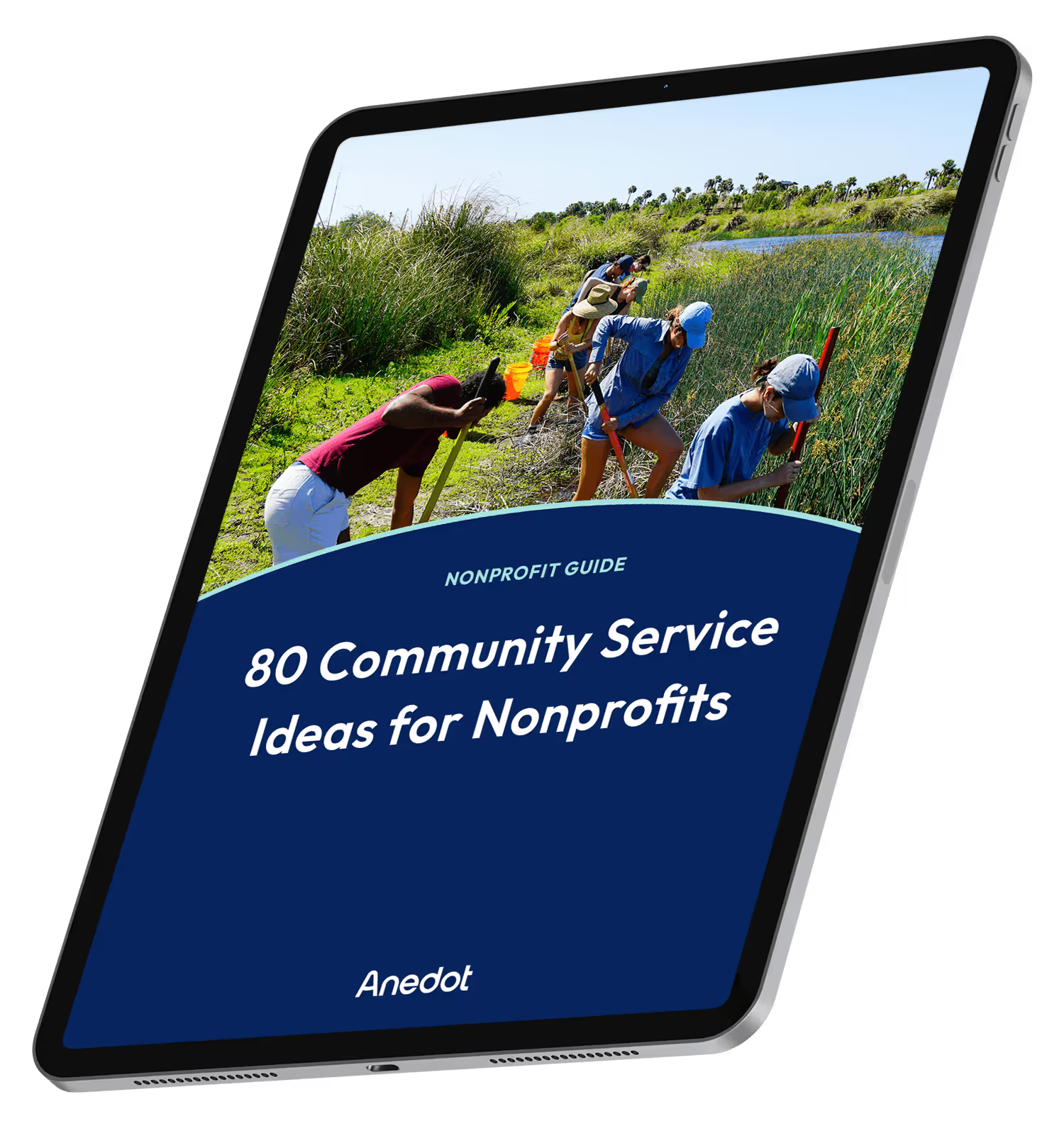
80 Community Service Ideas for Nonprofits
